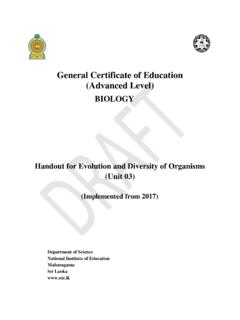Transcription of Introduction to Darwin’s Theory - Explore Evolution
1 Plenty of clues. Scientists from many different concepts. We'll introduce them here, and examine fields try to piece these clues together to come them in more detail later on. In the Origin of up with possible explanations. Darwin, himself, Species, Charles Darwin formulated a Theory with looked at many different lines of evidence as he two main claims. constructed his Theory . He considered biogeog- The first claim became known as the Theory raphy (how organisms were distributed over the of Universal Common This is the idea Earth's surface).
2 He also looked at comparative that every creature on Earth is ultimately descend- anatomy (how species resembled each other) and ed from a single common ancestor somewhere in embryology (how organisms develop). Darwin the distant past. This Theory paints a picture of also examined fossils the mineralized remains the history of life on earth a picture of a great of once-living organisms. branching tree. Darwin envisioned this Tree of Using the clues from each of these areas, Life beginning as a simple one-celled organism Darwin formulated his Theory .
3 That gradually developed and changed over many generations into new and more complex living Introduction to Darwin's Theory forms. The first one-celled organism represented To understand this book and the issues involved the root or trunk of the Tree of Life; the new in the discussion, you'll need to know a few key forms that developed from it were the branches. The Theory 's second main claim has to do with the biological process he thought was responsible for this branching pattern. Specifically, Darwin proposed a mechanism that he thought could cause existing living organisms to change, and cause new living forms to arise.
4 Darwin called this mechanism Natural Selection, and argued that it had the power to produce funda- mentally new forms of life. How could it do that? Charles Darwin observed that individuals within groups are not exactly the same. Cows from the same herd are not exactly alike. Even puppies in the same litter are not exactly alike. In other words, Darwin observed that organisms vary in their traits. Occasionally, these variations between individuals play a huge role in determin- ing which members of the group survive, and which do not.
5 For example, suppose that sea levels rise dramatically. During high tides, salt water flows into a nearby marsh that previously contained * Sometimes called differential survivability and differential reproduc- Figure i:3 The tree of life representing life's history, drawn tion, which is what you should call it when you're trying to impress your by Ernst Haeckel. Public Domain. parents with how much you're learning. Explore Evolution . evolved a bit since 1859. Darwin (and other biolo- More Likely To Survive = gists of the 19th century) did not understand how More Likely To Reproduce genetic traits were passed from one generation to the next.
6 In the early decades of the 20th century, n Variations arise at random. biologists learned about the mechanisms of n Nature selects the adaptive heredity ( , how traits descend from parents to (or successful) ones. offspring), and about mutations (randomly-arising changes to genetic material, a special kind of n Organisms with the adaptive trait variation). The modern evolutionary Theory called survive and reproduce. neo-Darwinism reaffirms the ideas of Universal n The offspring are likely to inherit Common Descent and the creative power of these successful adaptations.
7 Natural selection, and it incorporates this newer knowledge about heredity and mutation that n Inherited adaptations eventually Darwin lacked. Neo-Darwinism is the version of cause populations to change. the Theory we will examine in this book. Defining Some Terms Before we go any further, we have to get a few only fresh water. Salt is deadly to most plant life, definitions out on the table. As we look more but some plants can tolerate levels of salinity closely at Darwin's Theory , we're going to see that (saltiness) that would kill other organisms.
8 In some important terms mean different things the new salty environment, the salt-tolerant to different people. This can be a individuals will probably leave more offspring problem. As the 1990 California in the next generation than the non-salt- Science Framework states, The tolerant ( , dead) plants will. The process of teaching science requires a offspring of these salt-tolerant plants are precise, unambiguous use of language likely to inherit the salt-tolerance trait, which [and] Scientists, teachers, and students they will likely pass on to their offspring.
9 Must communicate the definitions of scien- Over time, Darwin argued, this tific terms and use them with consistency. 4. process (more likely to survive = Words must be defined clearly. When more likely to reproduce*) can cause someone uses the same word in more than permanent changes in species, and one way, it's called equivocation.. can eventually cause new living Let's look at a humorous example of forms to arise. how equivocation can lead to a Together, the ideas of Universal faulty conclusion: { }. Common Descent and natural selection form the core of Darwinian evolutionary To be obtuse.
10 Means to be stupid. Theory . They were first spelled out in Some triangles are detail in the Origin, and can be found obtuse. Therefore, in any biology textbook. some triangles are stupid. But Darwin's Theory itself has Introduction .



